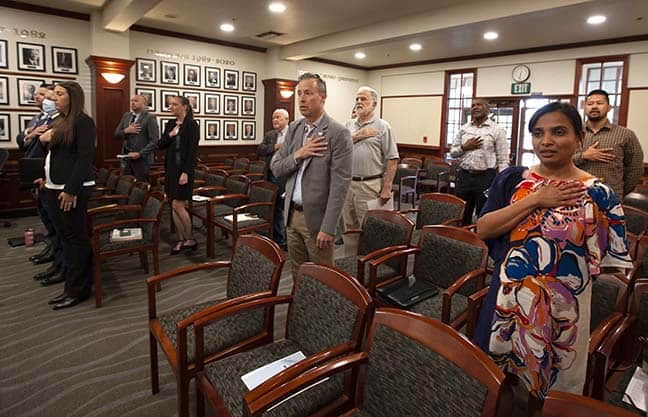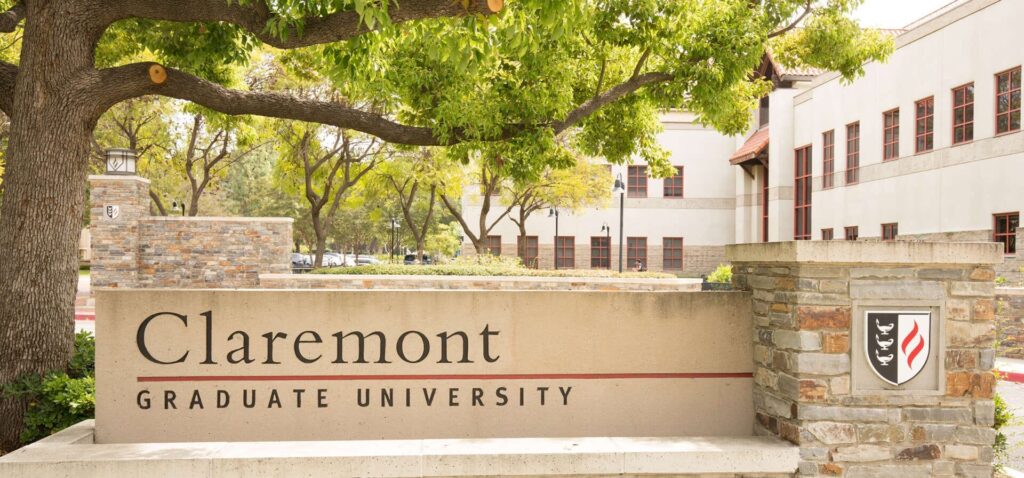City unveils plan to spend federal stimulus funds

City Staff and members of the public say the Pledge of Allegiance on Tuesday before the beginning of the Claremont City Council meeting. The council tackled a number of issues including allocating over $4.5 million in American Recue Plan Act funds. COURIER photo/Steven Felschundneff
by Steven Felschundneff | steven@claremont-courier.com
Tuesday night felt like that ’70s tune “Anticipation,” as the city finally revealed how it intends to spend Claremont’s federal stimulus dollars.
The city will get $8.7 million from the American Rescue Plan Act, it received the first disbursement of $4.3 million on July 9, 2021. Staff held off on spending any of that money until it received direction from the U.S. Treasury, which came in January when the final rule was submitted, providing cities greater flexibility in how the federal funds are used.
The intention behind the federal program, passed in March of 2021, was to repay cities for lost revenue due to the COVID-19 pandemic and to stimulate the economy. As such it came with some restrictions, including prohibitions on using the money for pensions, building up cash reserves, paying down outstanding debts or paying off judgments.
“The final rule provides state and local governments with increased flexibility to pursue a wider range of uses, as well as greater simplicity so governments can focus on responding to the crisis in their communities and maximizing the impact of their funds. Among other clarifications and changes, the final rule offers a standard allowance for revenue loss of up to $10 million. Recipient agencies that select the standard allowance may use that amount, in many cases their full award, for general government services, with streamlined reporting requirements,” according to City Manager Adam Pirrie’s staff report.
The city circulated two surveys to gain public insight, and received 385 responses from the one geared toward citizens, and 85 from business owners. Based on feedback from the community and the council, staff has developed proposals for spending $4,544,300, with $413,000 to be spent during the current fiscal year, and the remaining $4,131,300 to be included in the two budgets spanning from 2022 to 2024. That will leave $4,081,798 in unallocated ARPA funds, and city staff will submit spending proposals for that money at a later date.
The largest single expenditure of ARPA funds will be $995,000 to upgrade the police department’s communications system, with $500.000 going to an upgraded dispatch center and $495,000 to purchase 160 emergency radios at roughly $3,100 each.
The equipment will put Claremont up to date with the Los Angeles Regional Interoperable Communications System initiative, which aims to replace an old patchwork of systems with a state-of-the-art network.
“Public Safety agencies for 88 cities and the unincorporated areas of Los Angeles County currently use a patchwork of 40 aging radio networks. This means that agencies cannot readily communicate with each other, creating communications delays that waste time and imperil lives during emergency situations,” according to the staff report.
The second largest expenditure of $723,000 will go toward city technology upgrades, including a $100,000 update to the city’s website, which has not been revamped in years. The new design will be easier to use and will include accessibility features for people with disabilities.
The city will conduct an analysis of its existing software systems, many of which cannot communicate with each other, and staff proposes spending $400,000 in the next budget year on a comprehensive software upgrade. It will spend an additional $223,000 on new servers and back up systems.
Safe streets will get a boost from $500,000 spent on traffic calming measures including $250,000 on select street and intersections to improve pedestrian, bicycle and vehicle safety. The remaining $250,000 will be spent on a regulatory traffic sign inventory to identify any in need of replacement due to age, fading, loss of reflective surface or those that no longer meet the Federal Highway Administration’s Manual on Uniform Traffic Control Devices standards.
The city proposes spending $413,000 on one-time stipend payments for both full-time and part-time employees who worked at least 1,000 hours during the pandemic. Full-time public safety employees would receive $4,000, while other full timers would get $3,000. Part-time employees would receive $1,000 if they worked 500 hours.
Claremont will restore funding to community-based organizations and homeless services that had been cut due to “budgetary uncertainty.”
“These programs were previously funded in the amounts of $86,650 for CBO funding and $60,000 for homeless service funding. Staff proposes to restore this funding in the total amount of $146,650 in each of the next two budget years,” according to the staff report.
The Claremont Chamber of Commerce, which was cut from the budget in 2020, will once again receive city funding of $60,000, which restores not only the amount cut two years ago but brings it back to a funding level not seen since the Great Recession of 2009.
Claremont will help to stimulate its stock of available housing units by creating an accessory dwelling unit grant program, offering $20,000 to residents to offset the cost of building an ADU. The program will be funded at $200,000 per year over the next two years. The city will spend $50,000 more on developing five standard ADU designs that property owners could use at no cost, thereby avoiding the expense of architectural services.
Last month the council committed to spend $175,000 annually over the next two years to support a budget shortfall in the city’s Psychiatric Assessment Care Team. PACT responds to non-violent, non-criminal calls for mental health assistance received by the Claremont Police Department.
There will be two expenditures focused directly on our business community — a $400.000 grant program that could be used for expenses such as paying rent or utilities, and a blanket tax relief of the $135 license fee for all of Claremont’s businesses.
Finally, the city has proposed a commuter bicycle rebate program, which aims to free up some parking in the Village by encouraging employees to ride electric or push bikes to work. Getting workers out of cars would also have a positive effect on the city’s overall emission levels.
Councilmember Jennifer Stark initiated the debate by asking Pirrie whether the employee stipends could be extended to retirees who put in the requisite number of hours. He responded that such a move could be made for an additional $50,000.
Stark then inquired about the bike rebate program, asking if the city had any knowledge about how many people actually lived in Claremont and worked in the Village. Her chief concern was that the grant money could ultimately go to people who honestly don’t need it because they can easily afford to purchase bikes. She also questioned how many parking spots the program would really free up.
Mayor Jed Leano responded that the program would not solve any problems by itself, but could have incremental effect on both parking and lowering emissions.
Councilmember Corey Calaycay took exception to paying the employee stipends, reasoning that city employees, for the most, still had jobs when so many others in the community were unemployed during the pandemic. He questioned whether there were greater needs in Claremont for those resources.
Councilmember Sal Medina responded that from a business standpoint, you take care of the employees who took care of you during hard times.
The council elected to separate the employee stipend from the rest of the package and passed it 4-1 with the retiree payments added. Calaycay cast the lone “no” vote.
The council passed the remainder of the ARPA funding 5-0, but instructed staff to reevaluate the bicycle rebate program to add income qualifications and other tweaks.











0 Comments